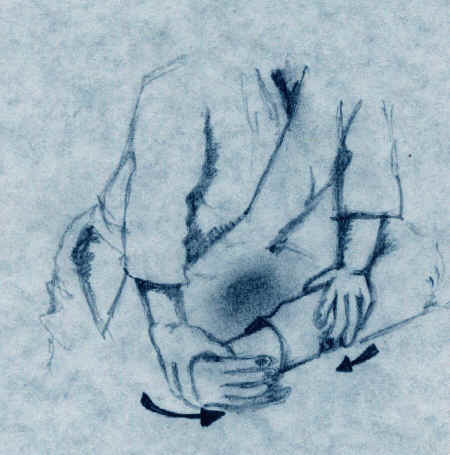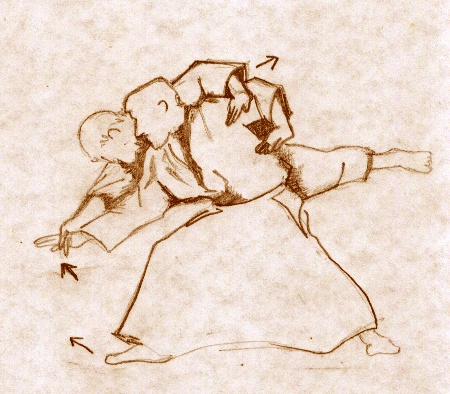FOR THE FIRST TIME IN the history of the SHUDOKAN !!!
Absolutely for his students world-wide awaiting to know of their loving
instructor, the icon and pinnacle of Shudokan Aikido-
Sensei Thamby Rajah !!!
An exclusive, exhaustive and in-depth feature on Sensei Thamby Rajah.........
Sensei Thamby Rajah has always been modest of his achievements and prowess. When questioned about his martial arts career his answers would largely be monosyllabic and curt. He shuns fruitless verbiage. Here, for the first time , and at the behest of his students , he opens up a few poignant experiences in the dojos of Japan at a time when most martial arts disciplines were in their infancy and down right raw and combat - oriented. Remember as you read along that you are treading backwards in history to about more than half a century ago, in terms of time, civilization, culture, value systems and most importantly the arraignment of martial arts techniques. It was also around the time when the embargo on the open practice of martial arts had just been lifted in Japan and the floodgates were flung open. Sensei Shioda had just drawn the curtain withholding the beauty of Aikido by his dazzling Aikido performance in the first All Japanese Martial Arts display after the lifting of the embargo. Read on with these happenings in hindsight , then only, shall you be aptly focused in the right perspective..... to comprehend the subject being juxtaposed here ! Aikido, at the time when Sensei Thamby studied was still "sizzling hot being fresh from the oven" , for Sensei Shioda had started studying it in 1932 ( Sensei Thamby in 1954) and the influence of Daito-ryu Aikijutsu, upon which Ueshiba sensei's Aikido was largely based, had profound influence on the art as dished out to students then. This may credibly appease the bafflement and awe of present-day students as regards some of Sensei Thamby's unconventional techniques.......At most times, he holds these techniques in abeyance from new students so as not to vitiate the evolvement of the art as taught by the recent instructors. With advanced students, who have had sufficient grounding in the art, he unleashes the range of traditional techniques as he was taught then. Mind you, they are darn effective, fast, deadly and "cool"... His techniques smacks of tradition, absolute pragmatism and superlative vigor. Read on to comprehend more of Sensei Thamby Rajah, the epitome of a true Aikidoist !!!
Sensei Thamby Rajah practicing Judo in Japan
Sensei Thamby Rajah speaks thus :
" My
interest as a school student was deeply entrenched in gymnastics. The state-of-
affairs at the school where I studied fostered the growth of my inherent interest in
sports. The school was administered by Christian missionaries from the
west and they believed in total humanistic education. Unlike the present - day schools academic and sports excellence were held
in high esteem and a lot of encouragement was given. Distractions in the form of
movies, TV, VCDs, computers and drugs were not rampant then. The grace and
agility of gymnastics captivated me and I was naturally excelling in this sport
soon. It was about this time that I was introduced to Jujutsu by Mr. Walter De
Silva . He taught me the rudiments of the art and being a sportsman I soon
developed a liking for it. Anything that was physical and required discipline
appealed to me. I was also keen in body-building and weight-training. School
boys then were disciplined, studious and valued health, physical culture and
cleanliness unlike these days. I loved my school-days and eventually after
completing my education ended up working, for a long period in my working
life, at my alma mater, the St. Paul's Institution in Seremban in
the administrative / clerical capacity. School discipline has definitely
deteriorated over the years and together with it the moral values As
regards martial arts, during those days there weren't any qualified
instructors to teach Japanese martial arts and there was in fact
absolute distaste for anything that was Japanese in nature because the atrocities they
had committed during their occupation of Malaya were fresh in the minds of the
citizens .
It
was in the early 1950's that I went to Japan to study Judo at the Kodokan - the
main dojo for Judo. Judo was popular then and there were many foreigners,
particularly westerners learning the art . Strangely, despite the fact
that I was training at the Kodokan, I never really got to meet Sensei Draeger.
He was a household name at the Kodokan amidst foreign students. He attended the later classes and I the earlier ones. I knew all his friends and
they were my friends too. I met Sensei Draeger only through a chance introduction by
Sensei Johnny Khoo and after that our friendship blossomed until his unfortunate
and untimely demise in 1982. He was a true martial artist and was adept at several martial
arts. Everyone in the Japanese martial arts arena knew him and of his dedication
to his chosen field - sort of a foreign leviathan in the ocean of martial arts.. He was very helpful and I remember him making arrangements
for both of us to visit Hokkaido to witness Aikijujutsu. However, the plan
fizzled out due to unforeseen circumstances. Even, after I left Japan he was a
regular visitor to the Seremban dojo. He was a great martial artist and scholar.
While studying Judo, I was gifted to be trained by great instructors like Sensei
Ichijima and Sensei Mifune. These great personalities left indelible impressions
on my mind. They were great teachers, disciplinarians and nice friends. I still
cherish my training days with them. You rarely find instructors of that calibre
any more. They lived for the art and breathed the art in their daily existence.
Alongside
Judo, I was also attending classes in Karate at the Japanese Karate
Association . Both the disciplines were tough and adherence to the instructors'
commands was the rule of the day. Contending with the study of both arts that
were in several ways diverse and varied was a monumental task. You get wrenched
out in terms of stamina and strength. It is the spirit and enthusiasm
that keeps you going on.
Japanese Karate
Association
Hachiman Dojo ( 1st Yoshinkan Aikido dojo)
The
Japanese instructors were outright strict and each technique had to be mastered
well .There was no special treatment for foreigners. Everyone was treated alike.
Sometimes you get to train with very brusque characters out to injure you if you
are not careful. Another problem was the language. I understood most of the
martial arts terminologies and friends helped me in the translations when
necessary. In the dojos there wasn't any talking but just training. You look at your sempai
and just followed them - every single move and action. It was also around
this time (1954) that I started studying Aikido under Sensei Shioda at the first
Aikido Dojo (Sokudo Hachiman dojo). Training was once a day from 4.00 to 5.00 pm
and my dear friend Sensei Cunningham was of immense help. He assisted me
by explaining the Japanese terms in English. I also remember training with him
in his makeshift dojo at his house. At that time, sensei Inoue and other senior
senseis at the present Yoshinkan dojo were young, fledgling sempais. Later when the dojo shifted to
Yoyogi dojo . I also trained
there and stayed with sensei Takeno. From Yoyogi dojo it was then the Koganei
dojo. The present Yoshinkan dojo is the Shinjiku dojo and I have not trained
there . However, several students of mine have been there. Most notable being my
nephew, Sensei Joe Thambu - the youngest foreign student to be
awarded the 5th dan by Sensei Shioda before his untimely demise in 1994.
Talking of Sensei Shioda, he was a very, very fast man on the dojo mats. You have to
observe very closely to understand what he did. Otherwise, it was unclear. One
slight lapse in your concentration and he gets you down on the mat. He was young
then and full of vigor, speed and power. In the dojo, there was no
dilly-dallying with the training for he was superlatively strict but a good
teacher. As regards the techniques then, they were done in one swift movement
and there was no Kihon-dosa, as you train today. The present-day
techniques are the same but have been broken down into several discrete parts to
facilitate teaching and learning. When done as one movement you see the link
between the past and present-day movements. It was hard training all along then.
Several students gave up unable to withstand the training. I remember being taught
Hiriki-no-yosei (with partner) and there was a lot of bokken training. A lot of
emphasis was on the basics and the training in Aikido was tiring as it involved
the entire body and mind. But, the gracefulness of the art and its effectiveness
kept me going. Once, the basics were mastered Aikido became interesting . Sensei
Shioda was the main dynamo at the dojo then. His charisma and mastery of his
field was way ahead of the other instructors. He was simply good.
My
association with the late Sensei Ted Stratton began in the 60's when he was with
the armed forces in Seremban. He had a natural flair for Aikido and martial arts
in general. He was a keen student and practiced hard and diligently. Today, the
growing popularity of Shudokan Aikido in United Kingdom is due to his untiring
commitment and vision. Sadly, however, time has overtaken him but he shall
remain in our minds as a good teacher and to all his students out there train
hard and in the manner he taught you. Personally, I have lost a good student and
friend.
Studying
martial arts is not just for acquiring dan rankings alone. You need to
develop a passion for it and it is not just a one-off attempt, like when you sit
for the school examination. You need to polish what you already know each day in
your mind and physically. Keep your minds open and train patiently,
intelligently and persistently. Master each move well. Don't be humbled if you
can't do it. Just keep doing and you shall be perfected in no time to your
amazement. The basics are the foundation and spend a lot of time perfecting the
basics well. Keep training and the beauty of Aikido shall reveal itself. "
A young Sensei Shioda then.
Demonstration by sensei Shioda before Senator Robert Keneddy
from the United States of America.
"
With love and sincere wishes to all instructors
and students of Shudokan Aikido "
From:
( Sensei K. Thamby Rajah )
Chief Instructor and Founder
Shudokan Institute of Aikido,
Seremban, West Malaysia.

OVER THE LONG SPAN OF YEARS.........
SOME OF SENSEI THAMBY'S TIPS IN THE DOJO WHILE TRAINING.
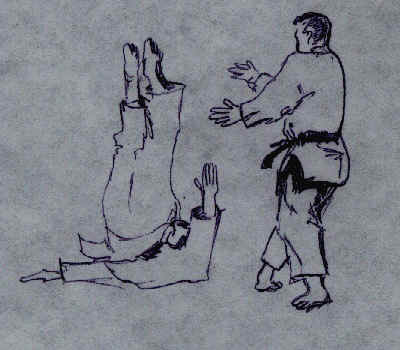
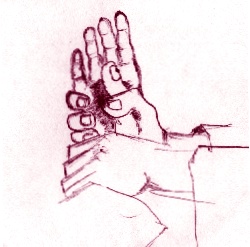
Always finish strong with good zanshin. In Nikajo, trap uke's thumb well.
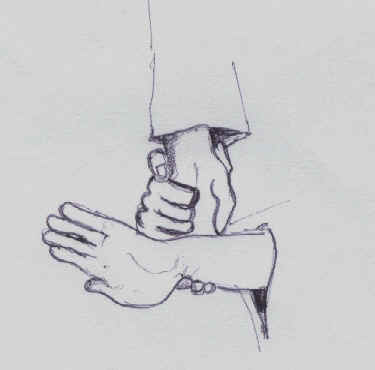
In Sankajo do not detach the gripped hand. Ensure your thumb grips uke's elbow.

Bokken training is crucial for kamae, Hijishime starts with twisting uke's
strong hands and lungs. wrist well (palm upwards).
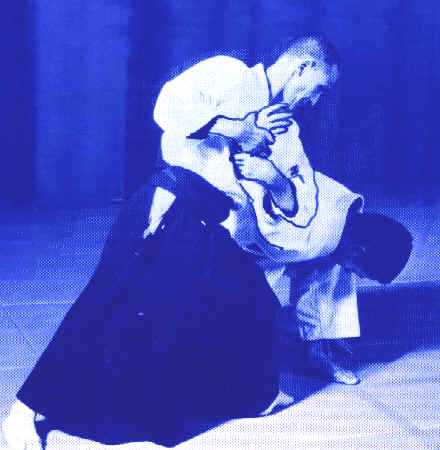
The body and mind must be one. The little finger in Aikido plays an important
Total engagement is the norm. role. It traps the wrist here and redirects the
oncoming momentum.
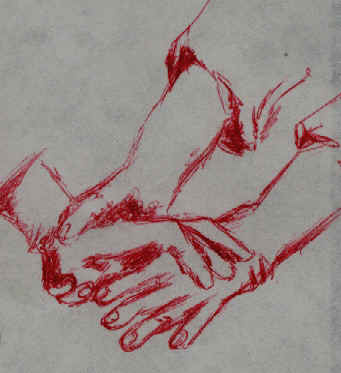
Keep your fingers open and let your Applying ikkajo is like kneading
fingers get the strength the flour
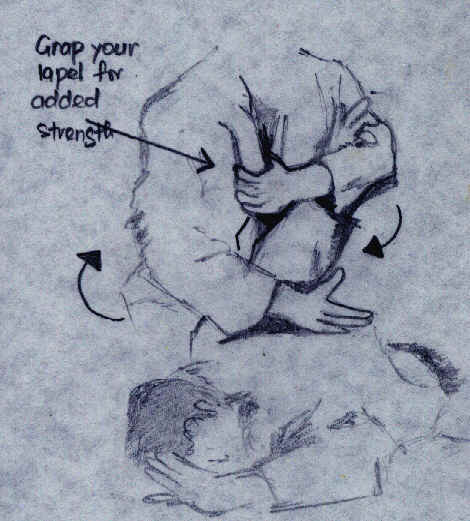
Grab your lapel for better hold The first finger points to the uke's face
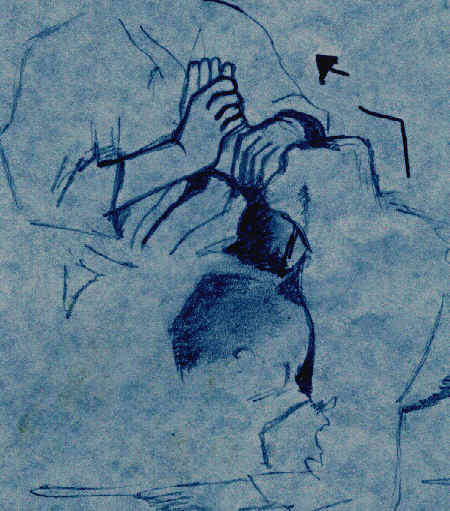
Lock by pushing your chest forward Open your shoulders wide, extend out
and reach forward to break the balance.More tips below :
- " In executing the Irimi-nage use your hip diagonally to finish the throw .
If you rely on just the hand power, it isn't sufficient for a powerful throw."
- "If a trainee's mind is persistently not on training, he rather not train and waste the
time of others. This is so with some children who train under compulsion from parents."
- " Empty your mind of all thoughts and your concentration ought to be just on executing
the techniques well. Nothing else."
- " Respect your partner. Always be of help to him. It has to be mutual otherwise, Aikido
techniques can't be studied well."
- " While being strict, do not be over-zealous and push the students up the wall. Gauge their
strengths and weaknesses and dish out the training accordingly. Let them enjoy the art !"
- "Don't rush through all the techniques. Take a technique and train in pairs for an hour. This
is an effective learning methodology in the dojo."
- " Aikido can be practiced by ladies and elderly people too. No need for muscles or too
much of strength. However, the teaching for them will be slightly lighter and slower."- " Aikido develops posture and poise. After a good workout in the dojo you are bound to
feel fresh and rejuvenated. "- " Train with everyone. Then you get to feel different joint-types and power."
- " If the dojo is overcrowded on a given day, then train the locks not the throws."
- " Aikido as an exercise form is total. It works the entire body. "
( All sketches, illustrations and compilations by A. Madawan)

